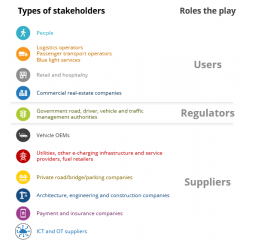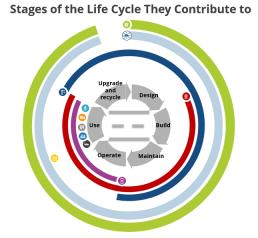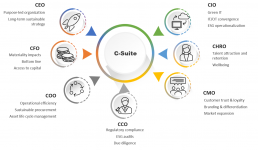Smart and Sustainable Roads: a Flourishing Ecosystem
The internal combustion engine was one of the most disruptive technologies of the past 150 years. It had long-term ripple effects not only on how fast and conveniently people and goods move, but also on our shopping and leisure habits, urban planning, and individual health and well-being. Some of these impacts were arguably negative; such as time wasted in congestion, pollution, and traffic accidents. To address those externalities policymakers, government traffic and transportation departments, car OEMs, and mobility ecosystems are reinventing vehicles and business models to reduce those externalities and eventually deliver on the promise of convenient, affordable, accessible, safe, and environmentally sustainable mobility.
The transition to next-generation mobility will depend on a new generation of vehicles that are connected, autonomous, and electric on shared and public mobility, and on rethinking urban planning to make it convenient and safe for people to switch to less impactful ways of moving such as cycling and walking. These new mobility models can deliver the expected benefits only if the way roads are designed, built, operated, maintained, used, and upgraded is transformed to make them possible.
Growing Investments in Smart and Sustainable Roads
Investments in smart and sustainable roads are flourishing in Europe and beyond. Examples include:
- The UK National Highway and Connected Places Catapult’s £1.7 million joint financing to fund innovative ideas and proofs of concept (POCs) for net-zero carbon road maintenance and construction materials and processes
- The city of Gothenburg is working with Volvo and other partners to test dynamic low-emission zones
- Italy’s highway and road authority Anas’ €1 billion plan to equip 3,000km of interurban roads with intelligent road systems and e-charging infrastructure
- Cities around the globe nudging logistics service providers to use smart pick-up and drop-off zones for delivery trucks, such as Barcelona which plans to impose a yearly tax on transport companies fulfilling home deliveries for using public spaces, to eventually nudge consumers to venture out to collect their own parcels (companies with a turnover of more than €1 million would have to pay an annual income-based tax of 1.25%)
Smart, sustainable roads are not to be intended merely as the instrumentation of roads with sensors and actuators to enable intelligent traffic management use cases, but it should be considered from a wider perspective. We define smart, sustainable roads as the intelligent use of technology across road design, construction, operation, maintenance, usage, and upgrade and recycle of materials to:
- Reduce cost of ownership and increase environmental sustainability across the design, construction, operation, and maintenance life cycle of physical road elements
- Enhance convenience, affordability, accessibility, safety, and environmental sustainability for the movement of people and goods
- Increase prosperity by enabling businesses to profit from new and existing economic activities related to designing, building, operating, maintaining, using, and decommissioning roads.
Next-Generation Use Cases Emerging at the Intersection of Multiple Industries
Smart roads are systems of systems. The value of technology innovation, such as IoT, AI, satellite imaging, lidar and electric mobility, is realized at the intersection of a network of stakeholders, the outcomes they aim to achieve, and the capabilities they need to implement to deliver those outcomes.
The Smart and Sustainable Roads Stakeholder Ecosystem
For example, to realize the benefits of:
- Electric mobility. Utilities, engineering and construction contractors, and road authorities need to work together to establish an accessible and affordable charging infrastructure; vehicle OEMs need to expand the number and battery range of electric and hybrid vehicles that they offer; payment providers must enable seamless settlement across different electric charging service providers; technology suppliers need to work with OEMs to embed connected vehicle capabilities for vehicle-driver interaction (e.g., trip planning, charging locations, pricing options) and vehicle-grid interaction (e.g., for smart charging and V2G applications).
- Low-emission or low-speed zones. Road authorities must work with technology suppliers to embed sensors in the infrastructure to count and monitor the number and type of vehicles, and they must share data with traffic departments to ensure enforcement of low-emission and low-speed regulations. Vehicle OEMs must embed connected and autonomous driving capabilities in their cars and trucks to make it easier for drivers to comply with regulations.
- Multimodal mobility as a service. Public transit operators must work with micromobility and shared mobility operators to enable integrated journey planning and payments, while road and traffic authorities must set up incentives, such as dynamic road pricing, to nudge people to explore options, beyond driving their own cars, while insurance providers need to offer plans that cover multimodal trips, rather than vehicle ownership.
To accelerate the convergence towards smart and sustainable roads ecosystem:
- Governments should evolve regulations and standards and monitor the impact of safety, accessibility, environmental sustainability and road service pricing policies.
- Transport operators, utilities and OEMs should connect their products and services to road infrastructure, such as traffic systems and e-charging systems to expand service offerings.
- Financial services should invest in smart road payment and insurance offerings.
- Retailers should scale on-the-move targeted advertising and shopping.
- AEC companies should invest in digital twin to increase the effectiveness and efficiency of designing, building, maintaining, and upgrading smart roads.
If you want to know more, please reach out to Massimiliano Claps
7 Sustainability Benefits for Your Business: Addressing the C-Suite Agenda
Did you know that Sustainability is the top business risk for CEOs in Europe, even above cybersecurity? (IDC EMEA, CEO Survey, January 2023, n=108). This is the first time sustainability has been at the top of the board’s agenda, and it is likely to stay for some time. But why is it a risk and not an opportunity? Why saving the planet is seen as a threat to business?
For many, climate change and the new sustainability regulations are a disruption to their operations. After all, today’s economy was built on the premise that Nature had given us a cheque in blank, with a limitless use of resources. How wrong it was.
Therefore, having Mother Nature behaving in the most unpredictable ways (e.g., heatwaves, floods, droughts) and government policies shaping business operations (e.g., taxes, quotas, disclosures) can be painful.
These are some examples: if you’re a semiconductor company with factories in South Asia, severe droughts can be material to your manufacturing processes as governments can prioritize water for local people. Or, if you’re a mobile phone manufacturer, the use of plastic packaging can be material to your business because of taxes or a complete ban by governments.
Sustainability is a moral, regulatory, and ultimately business mandate. There’s no opt-out: stakeholders are watching closely, e.g., customers, investors, business partners, regulators. As the executive of one of the world’s largest insurers shared in an interview recently “We don’t work anymore with customers that are not improving their sustainability. They are uninsurable for us“.
Therefore, if sustainability is indeed a risk, can companies turn it into a business opportunity? The answer is “yes”, according to most European companies (IDC EMEA, Future Enterprise Resilience, May 2023, n = 220).
Download eBook: Sustainability in EMEA: Opportunities for Tech Vendors, Challenges for Tech Buyers
Sustainability: Evolving from Risk to Opportunity
Sustainability can be a business opportunity if there’s a clear vision and commitment from leadership. Only then, “doing good” is embedded in every facet of work, across all business units, from procurement and production to logistics and customer service.
To make this happen, sustainability targets need to be fully aligned with the agenda and goals of each executive in the C-Suite. This is an illustrative example:
Benefits of Sustainability for Business
By addressing the agenda of the C-Suite, we can identify 7 reasons why sustainability is good for business:
- Chief Operations Officer (COO): Sustainability can drive operational efficiencies (IDC Global Sustainability Readiness Index, IDC, August 2023) across all business functions (e.g., supply chain, logistics, facilities). A sustainable firm is a fit and lean organization where “less is more”, e.g., frugality in resourcing water and energy.
- Chief Financial Officer (CFO): Investing in sustainable practices might not always deliver short term returns but can pay off in the form of resiliency and business longevity. CFOs have realized that the cost of “not acting” is greater than the cost of acting – for example, in their ability to access capital or insurance.
- Chief Marketing Officer (CMO): Sustainability is addressing the needs of a growing customer base. Buyers are looking for more transparency, honesty, and trust from suppliers. As such, brands with strong green credentials, integrity and social responsibility bring competitive differentiation.
- Chief Human Resources Officer (CHRO): Sustainability is a magnet in an organization, attracting and retaining talent. People are looking for purpose in their job and their companies (IDC EMEA Employee Future of Work Survey, March 2023). When work has direction is powerful and energizing: employees can work hard for goals they understand and feel connected to.
- Chief Information Officer (CIO): Sustainability, in an aim to reduce carbon emissions, can accelerate cloud migration, automation and optimization of IT processes (IDC Global Sustainability Readiness Index, IDC, August 2023). Moreover, based on the principle of frugality, IT assets can be rationalized based on usage and their lifecycle expanded as appropriate.
- Chief Compliance Officer (CCO): Sustainability can outshine a company against competitors in matters of corporate reputation and governance. The CCO can put in place strong stakeholder protections and build market trust.
- Chief Executive Officer (CEO): Sustainability can be a bold strategy for long-term business value. Leading with purpose can be inspiring, ignite passion amongst employees and create a culture of high-performance. B-Corps (e.g., Allbirds, Patagonia, Teapigs and Aesop) are testimony of it.
Register for the webcast: Sustainability in EMEA: The Challenge of Moving from Ambition to Action
Sustainability can be a force for good business and meet the C-Suite goals, but it needs execution for business impact (Global Sustainability Readiness Index, IDC, August 2023): it has to be internalized across the enterprise and become the “modus operandi” of getting work done, and for everyone, from the top to the bottom of the organization. But this is easier said than done. IDC research shows this is a roadblock for many enterprises: how to move from strategy to execution? Here is where the role of the Chief Sustainability Officer (CSO) comes into the picture.
Successful CSOs are executives with strong business acumen and digital skills, on the top of their sustainability expertise. Their role is not limited to appeasing the needs of different stakeholders, chiefly regulators and investors, but also a catalyst for business value creation through sustainability. Their reporting line should be direct to their CEO to give them stature in their organization.
CSOs are tech-savvy because technology is fundamentally the enabler to turn sustainability strategy into action and derive business value. For example, IoT and automation can optimize resource consumption in buildings and bring costs down; blockchain and AI can support resiliency in the supply chain.
In summary, sustainability can be an opportunity for business value when it meets the C-Suite goals. It needs a strategy that everyone in the organization understands and is passionate about – nothing is more fulfilling than knowing at the end of the working day you did something good for the planet and society. But, remember, it needs a CSO-led action plan and great technology to turn it into business value.
If you want to know more, please reach out to Angela Salmeron
Unleashing the Power of Industry Clouds: Tailored Solutions for European Business Excellence
In today’s rapidly evolving digital landscape, where technological advancements are reshaping industries at an unprecedented pace, the cloud has emerged as a beacon of innovation and efficiency. European businesses and governments have keenly embraced cloud technologies, harnessing their transformative potential to optimize operations, drive collaboration, and stay ahead of a dynamic digital market.
At the forefront of this cloud revolution is the concept of Industry Clouds – specialized platforms, applications, and services that offer industry-specific capabilities and operational prowess, revolutionizing how businesses across diverse sectors operate and excel.
A Shift in Cloud Dynamics: The Rise of Industry Clouds in Europe
The maturity of the cloud market in Europe has been steadily progressing, and forward-thinking organizations are strategically leveraging the unique advantages offered by different cloud platforms, applications, and services. The region’s robust infrastructure, bolstered by data protection regulations like the General Data Protection Regulation (GDPR), combined with the presence of established local cloud service providers, has expedited the adoption of cloud solutions across various industries.
Innovation, collaboration, and operational efficiency have become the driving forces behind European businesses’ embrace of cloud technology. Notably, the emergence of multi-cloud and hybrid cloud strategies has allowed organizations to tailor their cloud environments to their specific industry needs, adhere to local regulations, and fuel complex digital businesses that thrive on flexible infrastructure.
This holistic approach goes beyond mere migration, and moving out of legacy environments, looking for cost-efficiency, but marks a pivotal shift toward industry-specific solutions.
Empowering the Leadership: CTOs and CIOs in the Cloud Era
As cloud maturity advances, the roles of Chief Technology Officers (CTOs) and Chief Information Officers (CIOs) are undergoing a transformation. These decision-makers are no longer concerned solely with operational efficiency and scalability; they are now focused on strategic cloud implementation that drives tangible business outcomes.
The modern CTO and CIO are in search of solutions that not only streamline operations but also cater to the unique demands of their industries, thereby enhancing value for money and competitive advantage.
This shift in focus has paved the way for Industry Clouds to take center stage. As cloud providers, enterprise software vendors, and industry organizations fine-tune their offerings to align with specific sectors, CTOs and CIOs are empowered to harness cloud technologies that are tailor-made for their industries, sub-sectors and even use cases.
Deciphering Industry Clouds: Defining the Landscape
Industry Clouds, as distinguished from their conventional counterparts, are cloud-based platforms, applications, or services designed to offer industry-specific insights, technology, and operational capabilities. The hallmark of Industry Clouds lies in their vertical integration, modularity, collaboration features, and the potential to foster network effects. These specialized clouds encompass a range of services, including SaaS, IaaS, PaaS, DaaS, and various business operations-as-a-service.
What sets Industry Clouds apart are their unique characteristics. These clouds provide a suite of tools that agnostic cloud platforms and enterprise SaaS solutions simply cannot replicate. The focal technology capabilities encompass:
- Industry-specific data models
- Industry-tailored business process capabilities
- Pre-built blueprints and configuration templates
- Governance capabilities, including compliance and regulatory alignment
- Cross-industry collaboration options for seamless data sharing
- Specialized AI and analytics capabilities, including Gen AI
- Marketplace functionalities for optimized sourcing
- A PaaS platform for customized extensions and add-ons
These capabilities underpin the value proposition of Industry Clouds, allowing organizations to tap into solutions that are purpose-built for their sectors.
Navigating the Landscape: European Industry Clouds Research
The European Industry Clouds Research is a comprehensive exploration of industry-specific solutions. This research delves into the offerings of Cloud Service Providers (CSPs), competitive landscapes, adoption best practices across industries, and other critical aspects of these specialized platforms, applications, and services.
While the focus is primarily on CSP offerings, it also encompasses insights from industry players such as Siemens and Dassault, albeit in a more limited scope. Notably, the research excludes non-business solutions ecosystems, like government shared/community cloud platforms or collective standard-promoting platforms.
The research also extends into the realm of Cross-Industry approach, comparing and contrasting adoption rates across different sectors, evaluating offerings per industry, and dissecting the strategies of Cloud Service Providers, consulting organizations, and enterprise software vendors. This comprehensive exploration ensures a holistic understanding of Industry Clouds’ impact on various industries.
Industry Clouds vs. Industry Ecosystems: Navigating Complexity
Industry Clouds and Industry Ecosystems, while interconnected, are distinct concepts that play unique roles in driving innovation and business efficiency. An Industry Cloud Platform is a specialized, industry-tailored digital service offering data, blueprints, and industry knowledge to optimize operations within a specific sector.
In contrast, Industry Ecosystems encompass a broader network of businesses, partners, and stakeholders, promoting collaboration, innovation, and value creation on a larger scale. While Industry Clouds offer targeted solutions, Industry Ecosystems foster a collaborative environment that transcends organizational boundaries, nurturing multi-way value generation flows.
Embracing the Future: Leveraging Industry Clouds for European Business Acceleration and Resiliency
As European businesses continue to navigate the ever-changing digital landscape, Industry Clouds have emerged as a powerful tool to drive operational excellence, innovation, and competitive advantage. By tailoring cloud solutions to meet industry-specific needs, organizations are harnessing the full potential of cloud technology to create a transformative impact.
As we move forward, it is imperative for businesses to recognize and leverage the unparalleled benefits of Industry Clouds and Industry Ecosystems, ensuring sustainable growth and staying at the forefront of digital evolution.
To know more, please reach out to Anielle Guedes.
Sustainable Air Travel: What's on the Tech Horizon?
September through December are busy months for IDC analysts. Industry and tech vendor conferences and events are happening every week. Only over the next couple of weeks, I’ll be traveling first to Rome and then to Portugal and, every time I travel, I try to think of my carbon footprint.
Going to Rome is a no brainer, I’ll drive my hybrid car to the train station, then ride a commuter train to Milan, then a high-speed train to Rome, and eventually the subway to the hotel; I’ll ride electric end-to-end. Going to Lisbon, there’s no choice, I need to fly, unless I fancy spending two days on a bus. So, my carbon footprint will be much higher. True, Lisbon is much farther away than Rome, but still the average carbon emissions of a flight are much higher than those of a train.
Air travel executives know that policymakers, investors and passengers are expecting them to be more ambitious in terms of their environmental sustainability targets and are taking actions.
Download eBook: Sustainability in EMEA: Opportunities for Tech Vendors, Challenges for Tech Buyers
The Three Horizons of Sustainable Air Travel
In the immediate aftermath of COVID, somebody thought that doing more work, learning, getting entertained remotely would replace a lot of air travel, hence reduce emissions. But air travel came back with a vengeance.
Therefore, air travel executives need to rely on other levers to increase sustainability. One of the most critical is technology innovation. Technology innovation will play a strategic role to make air travel more sustainable through three waves.
- In the long-term, electric and hybrid electric propulsion aircraft will drastically reduce both carbon emission and noise pollution. But although air taxis are already technically possible, long-haul electric flight is at the research stage.
- In the medium-term, alternative fuels will reduce, but not eliminate emissions, and by 2030, they will not represent only about 10% of all consumption, according to the International Energy Agency.
Information and communication technologies (ICT) will help – for instance, AI is being applied to accelerate the discovery of alternative fuels, digital twins are used to design and develop electric engines for aircrafts – but they won’t be the critical enablers. These medium-to-long term changes will be dependent on biochemical, mechanical, and electrical engineering developments.
- In the short-term, it will be a whole different story. ICT will be strategic to make air travel more sustainable. From designing and operating more fuel-efficient routes, by integrating traffic control systems, such as the Single European Sky, which is expected to cut carbon emissions by around 10% per year, to applying AI and machine learning to reduce taxi time – American airlines intelligent gating program is providing the capability to save more than a minute of taxi time per flight. From implementing more sophisticated data collection and analytics to report scope one, two and three emissions more accurately and then offset them, to reducing airports’ energy consumption. From sharing data among airlines, global distribution systems, online travel agencies and brick-and-more travel agencies to nudge passengers to buy environmental sustainability products and packages, to partnering with railways to replace short-haul flights or better connect airports.
Register for the webcast: Sustainability in EMEA: The Challenge of Moving from Ambition to Action
I consider myself a quite environmentally conscious person, but then when I look back at my twenty plus years career in the ICT industry, I took so many flights that make my environmental conscience feel guilty. I hope that I’ll be able to travel on an electric powered airplane, someday.
In the meantime, there are plenty of opportunities to embrace ICT innovations to make air travel more sustainable. To learn more about airlines’ sustainability and other strategic and operational innovations enabled technology, take a look at IDC’s global research on the industry.










